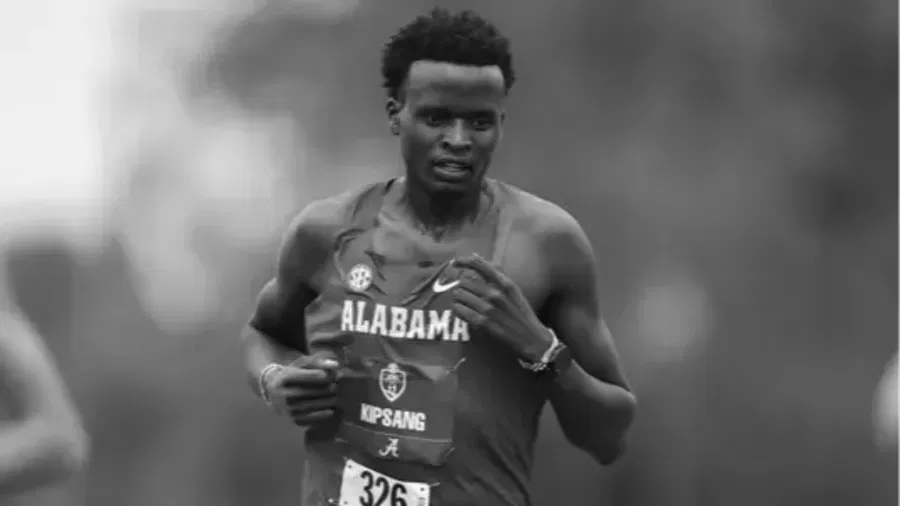At just 28, Kenyan middle-distance sensation Eliud Kipsang, a record-breaking NCAA star with the world at his feet, collapsed chasing his Olympic dream. And as his life slipped away in a U.S. hospital ICU on June 10, 2025, a troubling truth came into sharp focus.
Born in Kenya, Eliud Kipsang’s rise was a story of grit and grace. A standout at the 2019 Africa Championships, he crossed continents to pursue his dreams, running for the University of Alabama and etching his name in history with a blistering 3:33.74 in the 1500m in 2022, a record that held firm until March 2025.
Adidas signed him. Coaches banked on him. He was Eldoret’s next great hope. But none of that could shield him from a silent killer stalking young athletes across the world.
On June 6, 2025, Eliud Kipsang collapsed from sudden cardiac arrest while training in Washington. Rushed to Good Samaritan Hospital in Puyallup, he fought for four days in critical condition before passing. It was a devastating loss, but perhaps even more heartbreaking was the lack of safety nets around him in those final moments.
A GoFundMe campaign set up to cover his medical care and repatriation costs barely raised $1,260 of its $30,000 target, a damning reflection of how even elite athletes can be left adrift when crisis strikes. For a world-class runner under a major sponsor, the response was not just disappointing, it was cruelly inadequate.
A Worrying Pattern Emerging in Track and Field
Eliud Kipsang’s death joins a growing, grim list of young athletes lost to sudden cardiac arrest , a trend that has raised alarms but seen far too little systemic action.
In September 2024, 23-year-old Nefertari Holston collapsed mid-race at the MGA/Julius Johnson Invitational in Georgia. Despite swift medical intervention and a rush to hospital, she was pronounced dead hours later. The cause was cardiac arrest, possibly aggravated by sweltering 90°F heat.
Just months after, 16-year-old Espoir Missite from Maple Grove High School in Minnesota suffered cardiac arrest while trail running in February 2025. Bystanders attempted CPR, medics arrived quickly, but Missite too didn’t survive.
And back home in Kenya, 20-year-old Joseph Hussein Njagi met a similar fate. On September 27, 2024, after completing a 3,000m trial at Kipchoge Stadium in Eldoret, Njagi collapsed at the finish line.
Declared dead on arrival at Uasin Gishu District Hospital, his passing reignited urgent conversations around athlete health in Kenya, particularly during grueling scholarship trials where young runners risk everything for a shot at the big stage.
Hard Questions Sports Can No Longer Ignore

These tragedies, unfolding within a year of each other, lay bare an uncomfortable truth, our systems, whether in Kenya, the U.S., or elsewhere, are failing young athletes. Conversations about cardiac screenings, the presence of trained medical teams at events, and the importance of athlete welfare beyond their medals often surface only after lives are lost.
According to Essentially Sports, Mandatory health screenings for cardiac risk remain absent in many track and field programs globally. Access to defibrillators, professional medics at training venues, and clear emergency protocols are still inconsistent, and in many cases, non-existent.
Athletes like Kipsang, Holston, Missite, and Njagi deserved better. They deserved communities that matched their commitment with adequate care. They deserved federations and sponsors willing to invest not just in their victories, but in their health and safety.
A Global Call to Action
Kipsang’s death should not be another footnote in athletics’ history books. It must be a catalyst for change. From Eldoret to Alabama, from local trials to international championships, athlete safety needs to move from the sidelines to center stage.
It’s time to make pre-race cardiac screenings mandatory at all levels. To ensure that every meet , from school races to elite trials, has trained medics on standby. To normalize conversations about athlete mental and physical health not just in the aftermath of tragedy, but as a standard operating practice.
If the world can cheer for their records, it must also safeguard their lives.


